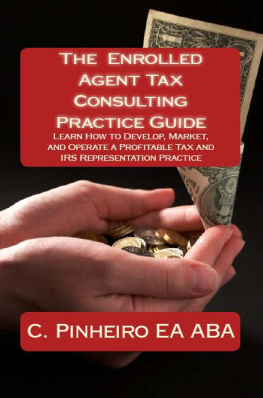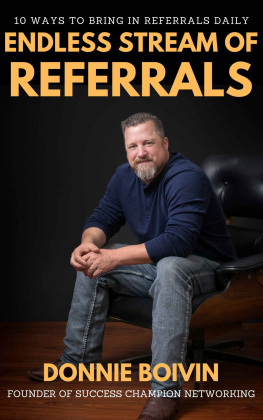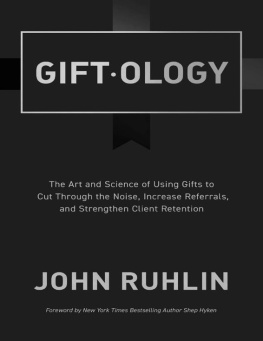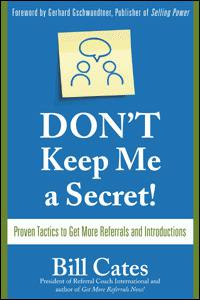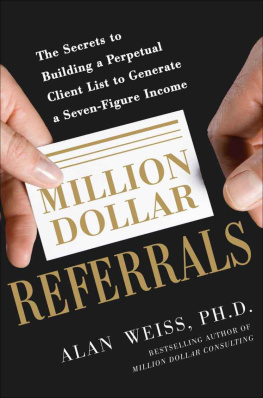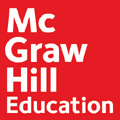
Copyright 2013 by Bill Cates. All rights reserved. Except as permitted under the United States Copyright Act of 1976, no part of this publication may be reproduced or distributed in any form or by any means, or stored in a database or retrieval system, without the prior written permission of the publisher.
ISBN: 978-0-07-179167-0
MHID: 0-07-179167-1
The material in this eBook also appears in the print version of this title: ISBN: 978-0-07-179166-3, MHID: 0-07-179166-3.
eBook conversion by codeMantra
Version 2.0
All trademarks are trademarks of their respective owners. Rather than put a trademark symbol after every occurrence of a trademarked name, we use names in an editorial fashion only, and to the benefit of the trademark owner, with no intention of infringement of the trademark. Where such designations appear in this book, they have been printed with initial caps.
McGraw-Hill Education eBooks are available at special quantity discounts to use as premiums and sales promotions, or for use in corporate training programs. To contact a representative please e-mail us at bulksales@mcgraw-hill.com.
TERMS OF USE
This is a copyrighted work and McGraw-Hill Education and its licensors reserve all rights in and to the work. Use of this work is subject to these terms. Except as permitted under the Copyright Act of 1976 and the right to store and retrieve one copy of the work, you may not decompile, disassemble, reverse engineer, reproduce, modify, create derivative works based upon, transmit, distribute, disseminate, sell, publish or sublicense the work or any part of it without McGraw-Hill Educations prior consent. You may use the work for your own noncommercial and personal use; any other use of the work is strictly prohibited. Your right to use the work may be terminated if you fail to comply with these terms.
THE WORK IS PROVIDED AS IS. McGRAW-HILL EDUCATION AND ITS LICENSORS MAKE NO GUARANTEES OR WARRANTIES AS TO THE ACCURACY, ADEQUACY OR COMPLETENESS OF OR RESULTS TO BE OBTAINED FROM USING THE WORK, INCLUDING ANY INFORMATION THAT CAN BE ACCESSED THROUGH THE WORK VIA HYPERLINK OR OTHERWISE, AND EXPRESSLY DISCLAIM ANY WARRANTY, EXPRESS OR IMPLIED, INCLUDING BUT NOT LIMITED TO IMPLIED WARRANTIES OF MERCHANTABILITY OR FITNESS FOR A PARTICULAR PURPOSE. McGraw-Hill Education and its licensors do not warrant or guarantee that the functions contained in the work will meet your requirements or that its operation will be uninterrupted or error free. Neither McGraw-Hill Education nor its licensors shall be liable to you or anyone else for any inaccuracy, error or omission, regardless of cause, in the work or for any damages resulting there from. McGraw-Hill Education has no responsibility for the content of any information accessed through the work. Under no circumstances shall McGraw-Hill Education and/or its licensors be liable for any indirect, incidental, special, punitive, consequential or similar damages that result from the use of or inability to use the work, even if any of them has been advised of the possibility of such damages. This limitation of liability shall apply to any claim or cause whatsoever whether such claim or cause arises in contract, tort or otherwise.
This book is dedicated to my daughter, Jenna Cates,
who continues to show me the joy and power of unconditional love,
and to the loving memory of my sister, Linda Cates.
The moment you permit your mind to dwell with dissatisfaction upon things as they are, you begin to lose ground. You fix attention upon the common, the poor, the squalid, and the meanand your mind takes the form of those things. You will then transmit these forms or mental images to the formless. Thus, the common, the poor, the squalid, and the mean will come to you. To permit your mind to dwell upon the inferior is to become inferior and to surround yourself with inferior things. On the other hand, to fix your attention on the best is to surround yourself with the best and to become the best.
The grateful mind is constantly fixed upon the best. Therefore, it tends to become the best; it takes the form or character of the best and will receive the best.
Wallace Wattles, The Science of Getting Rich (1910)
CONTENTS
SECTION I
Get More Referrals: Leverage
Your Successful Relationships
SECTION II
Get More Introductions:
Create Connections to Your New Prospects
SECTION III
Get More Appointments: Reach Your New
Prospects and Begin the Conversation
SECTION IV
Get More Clients: Confirm the New
Relationship with High-Value Clients
APPENDIX 1
Whats Your Referral Confidence Quotient?
APPENDIX 2
Professionals Never Stop Practicing
APPENDIX 3
Get Your Assistant or Staff Involved
FOREWORD
It is a real pleasure for me to write this foreword for my friend and colleague Bill Cates. Bill and I have known each other and worked together for years in the exciting business of selling and personal success. He is now the foremost authority in America on helping professionals acquire more and better clients through referrals, faster and easier than ever before, and helping companies build a thriving referral culture.
When I began selling in my early twenties, I received no training except the words go out and talk to as many people as you can. I worked for many months, making calls and going from door to door, making very few sales, and feeling both frustrated and inadequate. Finally, I began asking the question Why is it that some salespeople are more successful than others? The answers changed my career and my life. Once I learned how to sell professionally, my sales increased dramatically. Soon I was recruiting and training other people with my sales ideas. By the time I was 26, I was responsible for six countries and had 95 people under my control, each one of whom I had recruited and trained personally.
Since those early days, I have developed sales training systems that have now been used in 60 countries to train more than 2 million salespeople. Many of the graduates of my programs have gone on to lead their fields, become the top income earners in their professions, own their own businesses, and become self-made millionaires.
One of the factors I discovered was that top salespeople were professionals. They understood every part of the selling process, and they followed a definite plan and schedule to achieve exceptional sales results.
Another key factor I discovered was that top salespeople were extremely good at getting referrals from each customer or non-customer. These referrals led them to more and better sales, faster, and easier. Eventually, the top professionals I worked with developed their careers so that they worked by referral only.
I only wish that I had known the wonderful strategies and techniques that Bill Cates teaches in this book earlier in my career. By following these ideas, salespeople, small business owners, and professionals of all types can create more referrals and stimulate more word-of-mouth sales than they ever thought possible.
It turns out that the highest-paid salespeople in every field, and the highest-paid professionals, are all excellent at getting referrals from one client to another. And the good news is that this is a skill that you can learn, and quite quickly. If you ask properly, referrals are easy to get. Referrals cost nothing. Referrals dramatically reduce the amount of time it takes for you to get in front of a prospective client. Your closing ratio with referrals is higher. The sales process is faster. A good referral will lead you to other referrals from the customers personal and business circle. Referrals are truly the keys to the kingdom of sales success and high income.



